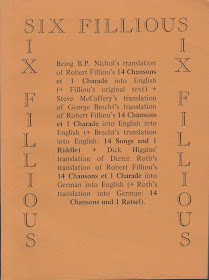

Publisher Karl Young on reprinting Six Fillious in 1978:
"Dick Higgins had spoken about reprinting Robert Filliou's 14 chansons et 1 charade, originally published by Editions Hansjorg Mayer. The original edition had included translations into English by George Brecht and into German by Dieter Roth. The set of poems by Filliou is set up in such a way that it could be used as the basis for a performance piece. In earlier conversations with Dick, I assumed he was thinking of reprinting the book himself.
The conversation between bp and I regarding the homolinguistic and other transformative procedures we had engaged in for some time extended to Dick who had also played with the idea. Play is an important word here - we definitely wanted something more obviously game-oriented than Louis Zukofsky's Catullus, a work we all admired, but saw going in a different direction and being read in a different way than we wanted our own work to go. I believe he first suggested trying something like that with the trilingual Filliou work. He and Barrie were enthusiastic about the idea, and more or less volunteered the unconscious McCaffery as the third participant. Several other people present spoke of extending the project at a later date. Jackson Mac Low was unsure of whether he would be able to do this or not, but definitely wanted to see what happened with the book as conceived with the six participants so far included. I would have liked to take a try myself, but since I was going to publish the book, it seemed best to wait and see if we could add other tiers at a later time. This was not solely altruism on my part - I knew I'd have enough expense with the six part book as it was.
We thus had a basic plan worked out during the conference, even though three of its six parts had not yet been written. The composition of those parts would act as extensions of performances into a book. Of course, we thought the party we found ourselves in would go on forever, and that we'd all transform the finished book into some kind of live performance at some other festival where we would all be present and the party would continue. If Dick were around now, I could imagine him holding forth on the memento mori theme, but he is one of the four who have died since the party within a party where this book began. Then again, a book of this sort does act as a perpetual echo of a celebration in which a group of people talked and laughed and shared ideas; other books may be seen as something similar on a smaller scale.
The first tier, Filliou's poem, with the translations of Roth and Brecht, was a high point of Fluxus. One of its forms of what I call triangulation was precisely literal: the work was published in three languages. It had a multi-media dimension in that it was set up as a group of performance pieces, which included the use of a jukebox. The positions of the original participants, including Hansjorg Mayer, had become canonical, and the book had achieved the status of a classic in the movement. My correspondence with the original participants in regard to doing the book proceeded in multiple Fluxist modes, from Mail Art to asynchronous statements. All this had a kind of purity to it, which amused me considerably given the bawdiness and irreverence of the poems.
The second tier brought the original classic into a new framework. Dick had been one of the original Fluxists, but the other three of us were not part of the original movement, or, for that matter, of the movement at all. Although homolinguistic translation is completely Fluxus-friendly, the original members would have seen Zukofsky, one of the models for the current group, as outside their fold. In the second tier, Fluxus itself was undergoing translation into other sensibilities, assumptions, tonalities, and formal properties. A basic Fluxus tenet was the possibility of transformation into entities and event structures which could not have been foreseen in the original first moves and manifestations. At its best, I'd like to see Fluxus as a movement that wished to see itself transformed into other genres and dispensation, eventually to the point of being unrecognizable. This book seemed to be at about midpoint in such a transition.
I had been able to buy some ocher colored French's Once Again line of recycled paper at a bargain price. This stock seemed perfect for the text and cover of the book, with blue-gray endpapers setting them off. I reproduced Mayer's type, and set the three new sections in a similar sans serif face. In the Production Department, the most fun I had in addition to the usual satisfactions of printing came from giving the book a full title which described it. This confused some bibliographers, and I don't think I managed to get any booksellers to list it completely and accurately, but I still had fun with it."
Readings from the text by Rafael Barreto-Rivera, Charlie Morrow, Paul Dutton, Dick Higgins, Alison Knowles, and Steve McCaffery, can be found here, as MP3 files.
Six Fillious is available from Specific Object, for $175 US, here.
The original can be purchased here, for just under a thousand dollars.

No comments:
Post a Comment